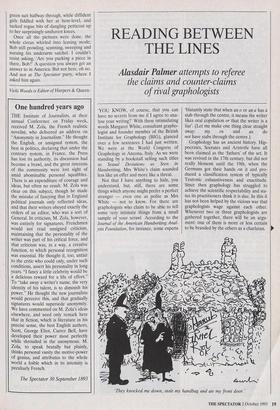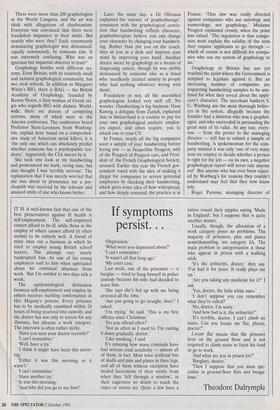READING BETWEEN THE LINES
Alasdair Palmer attempts to referee
the claims and counter-claims of rival graphologists
'YOU KNOW, of course, that you can have no secrets from me if I agree to ana- lyse your writing?' With these intimidating words Margaret White, consultant grapho- logist and founder member of the British Institute for Graphology (BIG), glanced over a few sentences I had just written. We were at the World Congress of Graphology in Ancona, Italy. As we were standing by a bookstall selling such titles as Sexual Deviations as Seen in Handwriting, Mrs White's claim sounded less like an offer and more like a threat.
Not that I have anything to hide, you understand, but, still, there are some things which anyone might prefer a perfect stranger — even one as polite as Mrs White — not to know. For there are graphologists who claim to be able to tell some very intimate things from a small sample of your scrawl According to the Journal of the American Handwriting Anal- ysis Foundation, for instance, some experts 'blatantly state that when an a or an a has a stab through the centre, it means the writer likes oral copulation or that the writer is a liar'. (Let me make one thing clear straight away: my os and as do not have stabs through the centre.)
Graphology has an ancient history. Hip- pocrates, Socrates and Aristotle have all been claimed as the 'fathers' of the art. It was revived in the 17th century, but did not really blossom until the 19th, when the Germans got their hands on it and pro- duced a classification system of typically Teutonic exhaustiveness and exactitude. Since then graphology has struggled to achieve the scientific respectability and sta- tus its practitioners think it is due. In this it has not been helped by the vicious war that graphologists wage against each other. Whenever two or three graphologists are gathered together, there will be an argu- ment: one of them is more or less certain to be branded by the others as a charlatan.
'They knocked me down, stole my handbag and ate my front door.' There were more than 200 graphologists at the World Congress, and the air was thick with allegations of charlatanism. Everyone was convinced that there were fraudulent imposters in their midst. But exactly who were they? Each venomously denouncing graphologist was denounced, equally venomously, by someone else. It was extremely confusing. Who was an ignorant but impartial observer to trust?
Graphology bristles with different sys- tems. Even Britain, with its relatively small and isolated graphological community, has two rival schools. In addition to Margaret White's BIG, there is BAG — the British Academy of Graphology, founded by Renna Nezos, a fiery woman of Greek ori- gin who regards BIG with disdain. World- wide, there are dozens of competing systems, many of which were at the Ancona conference. The conference heard Professor Stein-Levinson, from Washing- ton, explain hers: based on a comprehen- sive study of American serial killers, it is 'the only one which can absolutely predict whether someone has a psychopathic ten- dency'. Apparently the CIA swears by it.
She took one look at my handwriting and pronounced me stark, raving sane, but also thought I was 'terribly nervous'. The explanation that I was merely worried that she was about to pronounce me a psy- chopath was received by the tolerant and amused smile of one who knows better. Later the same day, a Dr Oliveaux explained the 'science' of `graphotherapy': consistent with the graphological convic- tion that handwriting reflects character, graphotherapists believe you can change your character by changing your handwrit- ing. Rather than put you on the couch, they sit you at a desk and improve your mind by improving your hand. Another doctor swore by graphology as a means of diagnosing cancer, though he was swiftly denounced by someone else as a fraud who 'needlessly created anxiety in people who had nothing whatever wrong with them'.
Fraudulent or not, all the assembled graphologists looked very well off. No wonder. Handwriting is big business. Hans Kanzig, a delegate from Zurich, explained that in Switzerland it is routine to pay for your own graphological analysis: employ- ers expect, and often require, you to attach one to your CV.
In France, nearly all the big companies want a sample of your handwriting before hiring you — as Jacqueline Peugeot, wife of the Peugeot of Peugeot cars, and Presi- dent of the French Graphological Society, stressed. Earlier this year the French gov- ernment toyed with the idea of making it illegal for companies to screen potential employees by checking their handwriting, which gives some idea of how widespread, and how deeply resented, the practice is in France. 'That law was really directed against companies who use astrology and numerology, not graphology,' Madame Peugeot explained crossly, when the point was raised. 'The regulation is that compa- nies must explain the validity of the tests they require applicants to go through — which of course is not difficult for compa- nies who use my system of graphology to do.'
Graphology in Britain has not yet reached the point where the Government is tempted to legislate against it. But an increasing number of companies are requesting handwriting samples to be ana- lysed for what they reveal about the appli- cant's character. The merchant bankers S. G. Warburg are the most thorough believ- ers in the system, allegedly because the founder had a mistress who was a graphol- ogist, and who succeeded in persuading the great man of its value. At any rate, every- one — from the porter to the managing director — still has to submit a sample of handwriting. A spokeswoman for the com- pany insisted it was only 'one of very many tests we employ to decide whether a person is right for the job — on its own, a negative graphological report will never rule anyone out'. But anyone who has ever been reject- ed by Warburg's for reasons they couldn't understand may feel that they now know why.
Roger Parsons, managing director of Rea Brothers, another banking firm which also employs a graphologist, explained that in his view a graphological analysis 'will raise areas of concern which we will plumb by further interviewing. You have to remember that, particularly at the top level, recruiting the wrong person for the job can be a hugely expensive mistake. Anything which can help you avoid that mistake has got to be worth it. In my expe- rience, graphology does exactly that.'
Ethics aside, if I wanted a job with War- burg's or Rea Brothers, or someone was assessing me as a potential marriage part- ner, what would a graphologist tell them about me? BIG's Margaret White pro- duced a very comprehensive report, a lot
of which I can only call astonishingly per- ceptive and accurate. My writing shows me to be a 'highly intelligent man, who can cleverly link and associate ideas'. (Abso- lutely right.) I have an 'inquisitive and questioning mind'. (How true!) I am an 'enthusiastic and tenacious man who always sets out to do a thorough and com- plete job'. (Employers please note.) Other claims, I felt, were less accurate. I 'proba- bly enjoy climbing and or sailing'. (I don't.) And I 'do not suffer fools gladly'. (I do — I have to. I meet too many in the course of my job not to.)
BAG's Amanda Clarkson came up with a much shorter analysis — my deadline, she explained, did not allow her to pro- duce a larger version — which also con- tained many undeniable truths. I have 'an enquiring and receptive mind', and am 'astute and quick-thinking'. I am 'well organised on a professional level' and am a man 'with warmth and diplomacy'.
These comments were flattering. They certainly disposed me to believe that graphology was well able accurately to read a person's character — an impression re-inforced when I gave Amanda Clarkson two further handwriting samples to assess, and she accurately identified the profes- sions of each (a cartoonist and a writer) and some of their critical psychological characteristics.
But if graphology were a technique for diagnosing disease, it would face very tough tests aimed at proving it did not work. How does it stand up to the psycho- logical equivalent of those tests? There have been a number of attempts to mea- sure its accuracy. The results are not encouraging. According to Professor Lievens, of the University of Ghent, not one has shown a statistically significant correlation between a given handwriting quirk and a particular temperamental char- acteristic. In fact, the correlation co-effi- cient is not merely too small to be statistically significant, it is actually zero.
Professional graphologists do not attempt to deny those results. They try to explain them away instead. 'The problem is that the tests were done by psychologists,' says Renna Nezos, 'and they hate us because they think we're a threat. They also used fraudulent graphologists. If they'd used real graphologists, they would have got a totally different result. Anyway, you cannot isolate one feature of handwrit- ing and correlate it with a temperamental characteristic. That's not how graphology works.'
Possibly. But the fact that the only scien- tific work there is on graphology totally fails to establish its accuracy has seriously damaged its claims to be a 'science'. The consequent rejection by the political and scientific establishment hurts. 'I have writ- ten frequently to Virginia Bottomley,' sighs Margaret White, 'telling her that we can tell paedophiles simply by looking at their handwriting. You don't need a whole legal investigation for that! We could save the country millions. Of course, she's never replied, the fool . . .' That may be one of Mrs Bottomley's better decisions, though not one which will increase her popularity with graphologists.
Reliable or not, graphology is growing. Further integration with Europe will mean more British firms will copy their continen- tal counterparts and start treating a graphological analysis as an integral part of the selection process. But those of you with terrible handwriting should not despair. You can always enlist in a course of graphotherapy. According to the grapholo- gists, it works.




















































 Previous page
Previous page